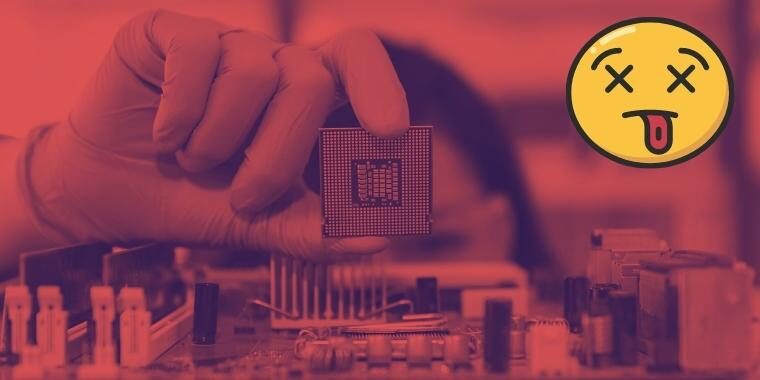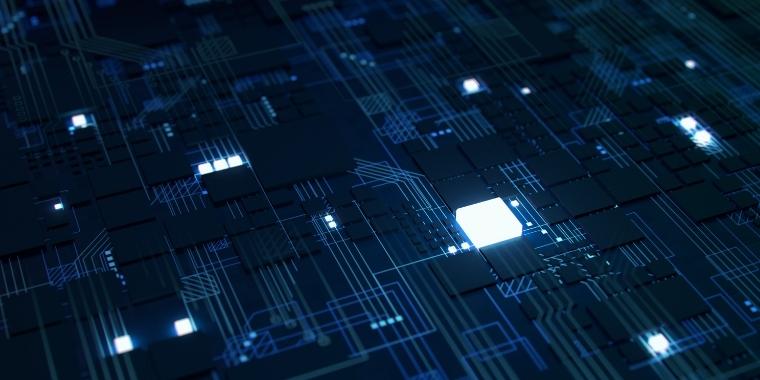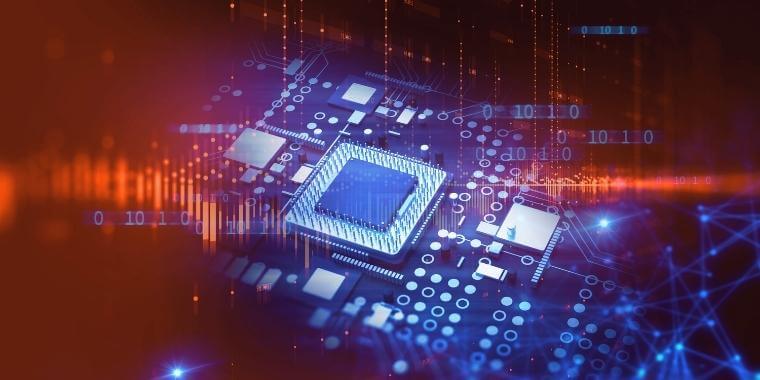
A dead CPU can cause a computer to not boot up. However, there are many signs that the processor is broken before it will no longer work. This blog post will explore what to look for when determining whether your CPU is dead or not, why CPUs might fail, and tips on how to prevent them from failing in the future.
Ready to jump in? Let’s go!
What Are The Signs Of a Dead CPU?

Computer Is Not Turning On
A computer that won’t turn on may be another indication of a dead CPU. You may press the power button and discover that your computer does not respond. Sometimes it may start and shut down after a few seconds.
It’s a very all-encompassing symptom, so it might point to a variety of issues other than your CPU being dead. It’s one of the most common ones though so make sure that you won’t ignore it.
Computer Is Slower Than Usual (Freezing / Lagging)
It might happen at any time, whether your computer boots up, is idle, or is under heavy use (e.g., you have a lot of apps running simultaneously). It’s most likely to occur when you least expect it, but if it does, don’t ignore it.
Important note: When things start to slow down, your computer becomes unresponsive, it’s likely that the CPU is overheating. There are many factors that can contribute to this problem. Most of them include a damaged GPU or RAM, but because it might be the source of a dead CPU does not imply you shouldn’t check your CPU temperature. You can use one of these programs to accomplish this: HWMonitor or Coretemp.
Blue Screen of Death (or actually Black Screen of Death*)
A blue screen of death (BSOD) is a system error or fatal error in Microsoft Windows operating systems. The blue screen of death occurs when the operating system fails to function normally. BSODs can be caused by a variety of factors, one of which is faulty hardware.
When your computer has a blue screen, an error code will appear. This tells you what happened and why the computer cannot function safely.
*Windows 11 comes with Black Screen of Death, but it’s still doing the same thing.
System Shutting Down Automatically
The main reason for that to happen is severe overheating. The system may have shut down automatically to prevent any further damage.
Overheating of the CPU is frequently due to malfunctioning fans. Remember to keep an eye on them at least once every two months to ensure that they are functioning properly.
Beeping Sound
When you try to turn your computer on it’s doing POST (Power-On Self-Test) diagnostic testing sequence first. That means that your computer is checking if all the hardware is working correctly. If it’s not then forces the motherboard to emit a signal. Instead of booting up your computer is beeping. Pay attention to the number of beeps you hear. If it’s 5 then it means that the CPU has failed. (Check this post for more motherboard beep codes)
Damaged Pins And Burn Marks
One indication could be a burned smell coming from the CPU, which is usually caused by too much heat or possibly an electrical short circuit.
Damaged pins are another frequent problem with processors. If one or more of the processor’s pins are either broken or bent, it will be unable to function properly.
There’s a very small chance that you may spot some burn marks on the circuit board. This simply implies that the CPU is dead for good. You should avoid using your computer until it has been repaired.
Overclocking
Overclocking a CPU can result in permanent damage if done incorrectly or excessively. Especially if no cooling is available. What’s more important overclocked CPUs are very often not covered by the manufacturer’s warranty.
CPU is Dead or Something Else? (Run Some Checks And Eliminate False Positives)

It’s hard to troubleshoot your PC, and it takes a lot of effort. Especially when you consider that one symptom might be caused by many causes. It’s much easier to diagnose your PC if you have the appropriate knowledge and access to software that will help you. As a result, I’ve compiled a shortlist for you. It’s [number] that will help you find the root of the problem.
Reset Everything
Reset all your hardware. That includes your CPU, heatsink, Video card, every RAM stick, and hard drive. There’s a slim possibility that at least one of these components isn’t installed correctly. (Sometimes it’s good to have a test computer where you can test every component separately) If you are wondering how can you do that, you can simply follow the steps from the video below
Test each piece of hardware in isolation
Testing your computer by removing a part at a time and testing it after each change is a good way to figure out what is wrong with your computer.
Replace each component
If the problem has not been fixed after following the above procedures and you still have spare parts, attempt replacing and installing them in your system. If a specific component is replaced and the problem is resolved, it’s probable that the component was bad.
Reapply thermal paste
This may seem like an odd one, but many symptoms of a broken machine are caused by overheating. Overheating is very often caused by a lack of thermal paste hence reapplying thermal paste may help to fix the issue.
Related article: What should be normal CPU temperature when gaming?
Clean the dust
Dust is a typical reason for computers to overheat. Dust may cause a lot of problems. If any dust particles make it past your motherboard’s seals, they could form a solid connection and eventually cause your computer to overheat.
What are the Common Causes?

Motherboard Is Failing
The motherboard is designed to connect all of your components so that they may communicate with one another. A bad motherboard often triggers other hardware failures as well. The motherboard’s major function is to ensure that all of your components are supplied with the correct voltage. CPU failure can be caused by excessive voltage if the settings are incorrect.
Power Surge
A power surge is an increase of voltage beyond the standard range. When a power surge is strong enough, it can damage your computer’s central processing unit (CPU) or other components. Not only does a sudden power surge have the potential to destroy a computer’s hardware, but it can also cause data loss.
Overclocking
Every time you overclock one kitten dies. I’m kidding obviously but jokes aside – it reduces the lifespan of your CPU. This is why it’s so important to have a proper cooling system in place. On top of that, it’s good to run a stress test before you overclock (you can use software like Aida64 that places 100% load on your CPU). It’s good to monitor your temperature on regular basis (with a tool like HWMonitor)
Your Computer Is Getting Old
This may be a surprise to you but CPU have an average life expectancy of 15-20 years. But only if they are kept cool and maintained, which is not always the case because other PC components have a shorter lifespan. The rise in temperature is frequently caused by a faulty fan, cooling system, or out-of-date thermal paste. That’s why it is important to keep eye on every single component and do your checkups regularly.
Too High Ambient Temperature
It’s best if your computer is in an open area with lots of air movement. Avoid putting it in locations where other items have congregated. It will also gather dust when you put it near a window or the edge of a room.
The temperature of the surroundings may also have an impact on CPU temperatures. According to a typical rule-of-thumb, a 5°F room temperature change equates to a CPU temperature change of approximately 7.5°F.
Prevention: 7 Tips To Keep Your CPU Healthy

Monitor Your CPU’s Temperature
Extreme heat can not only affect your PC’s performance. It can also significantly reduce the life of its components. Tracking CPU temperatures is essential for both gaming and workstation PCs. The following are the three best tools for monitoring CPU temperature during gaming sessions:
- Core Temp: Core temp is a reliable tool for monitoring CPU temperature in real-time, no matter how long you play. Coretemp provides all users with the ability to record their system’s temperature history. It also offersc custom graphs to monitor its individual temperatures (core max/min & room).
- HWMonitor: this software is one of the most popular monitoring devices for testing CPUs. HWMON provides all users with an automatic CPU IC temperature reading tool, fan speed visualization, and tools to monitor GPU, HDD/SSD temperatures as well.
- Real Temp: Real Temp is a popular CPU temperature monitoring software. It provides users with an array of features like scripting and a basic thermometer, enabled by double-pane and drag and drop system configuration to monitor CPU (core & other sections).
Regularly Clean Your Computer From Dust
To prevent the buildup of dirt in your computer you should regularly clean off dust, lint, and fur that gets separated by air intake vents using an anti-static brush. The more often can keep fresh air moving through it to ensure all parts inside perform properly.
Do this at least once a month or even once every week in order to clean off the dust and debris that has been collected inside. If you have a specific area in mind, go ahead and use an anti-static brush with some compressed air from your computer when cleaning it up. (I used this compressed air duster).
Get an AIO/Liquid Cooler
An all-in-one liquid cooler (AIO) is a computer component that combines the CPU, motherboard, and power supply into one unit. Many AIOs also include an expansion slot like a motherboard which allows for upgrades such as graphics cards and memory without having to replace the entire PC.
Most users prefer to buy prebuilt PCs with an included AIO because of the ease of assembly. This is not always true though. Some users build their own prebuilt PCs with an AIO because of the perks that come with it. For example, setting up your PC is much easier when you can just insert all necessary components into one board.
Installing an All-In-One in a system without its expansion slot or motherboard brings about fewer problems when installing upgrades like liquid cooling systems and multiple fans that blow into one radiator.
Use Good CPU Heatsink
If you are not into liquid cooler then you may think about improving your heatsink. CPU heatsinks are important as they help to control CPU temperatures, which can greatly improve long life and performance. Thermal resistance, material, fin configuration, fin size and shape, fin efficiency – these are only a few things that you should think of when buying a good heatsink. If you are into that option I strongly recommend this model as it’s a great value for money.
Take Care of Ambient Temperature
The temperature of a room can impact the computer’s performance and longevity. It is recommended to move a computer to a colder location when it becomes too hot in your home or office. It is important to not overheat your CPU. The heat will eventually affect it and too high a temperature can raise CPU temperatures by up to 50 degrees Fahrenheit (10 degrees Celsius).
Use Surge Protectors
Many people think that surges can only be caused by lightning. The truth is that your home may go through many little surges throughout the day. This is exactly why you should use surge protectors as they have a specific amount of surge they can protect you from. They will also work on top of your PSU and CPU protection mechanisms.
The protection is measured in “joules,” which is a unit that indicates how much energy passes through. According to Rytec Electric, you should always pick surge protectors over power strips. They will also protect devices from a flux in electricity.
Think About Case With Good Airflow
A new or upgraded case with good airflow is an investment in your PC’s longevity. The more air that can flow through your computer, the easier it will be to keep it cool and prevent overheating. In some cases, a case upgrade is not only beneficial for keeping computers working at their best but also as a way to improve performance. Improved airflow can greatly improve a user’s gaming experience.
In the same way that upgrading your PC case allows for better performance. You should also be looking at later models of cases with upgraded features or performance improvements to ensure the continued use and reliability of any computer equipment.
Troubleshooting a Dying / Bad CPU

So, your CPU died and you replaced it. You’re likely thinking that everything will return to normal. It may come as a surprise to you, but if you haven’t made any changes and don’t know why your CPU failed, it could happen again faster than you anticipate. Here are the minimum things you should do after purchasing a new CPU:
- Check if your motherboard is working fine.
- Check if your heatsink is plugged in correctly and it’s working
- Check if all your fans are working properly
- Check airflow in your computer
- Keep your eye on CPU temperature
Some questions you may have on “how to tell if CPU is dead”

Connect your PC to an outlet and turn it on. If everything is in order, you should hear and see your CPU’s fans operating. If that’s the case, and your computer boots up, then your CPU is in good working order.
If your computer won’t start then listen carefully to how many beeps you will hear during the BIOS POST test. If it’s anything other than 5 then the only good news is that your CPU is fine, but some other piece of hardware is not working.
They can, but often it’s the result of an electrical short circuit that causes a power outage.
CPUs can die because there are many integrated components in processors that need space to work and heat to dissipate. If any one of these integrated components stops working, even for a brief period while the system is being powered on or off, then permanent damage can occur to other integrated components or other parts of the processor.
A CPU can die simply by a flaw in its manufacturing, or a lack of air to cool it. What’s more, is that many computers’ CPUs are now “mesh” instead of surrounded by segregated metal cooling ducts. That means there’s much less to protect them from dust and dirt that might obstruct their fan blades or clog the surface as it heats up.
Remove everything from the motherboard, including the CPU, and turn it on to run the POST test. Obviously, without any hardware connected to your motherboard, the test will fail. Yet, it will allow you to check if the motherboard is working as it should.
Expect that you will hear a beep sound during the POST test. If you hear 2 beeps that means problems with your motherboard. If you hear less or more than 2 beeps then it means that your motherboard is completely fine.
Summary
Hopefully, this post has helped you determine what to look for when determining whether your processor is dead or not. While CPUs are durable and can be used until they no longer work, there are many signs that the processor is broken before it will no longer boot up. So just keep eye on it on regular basis.